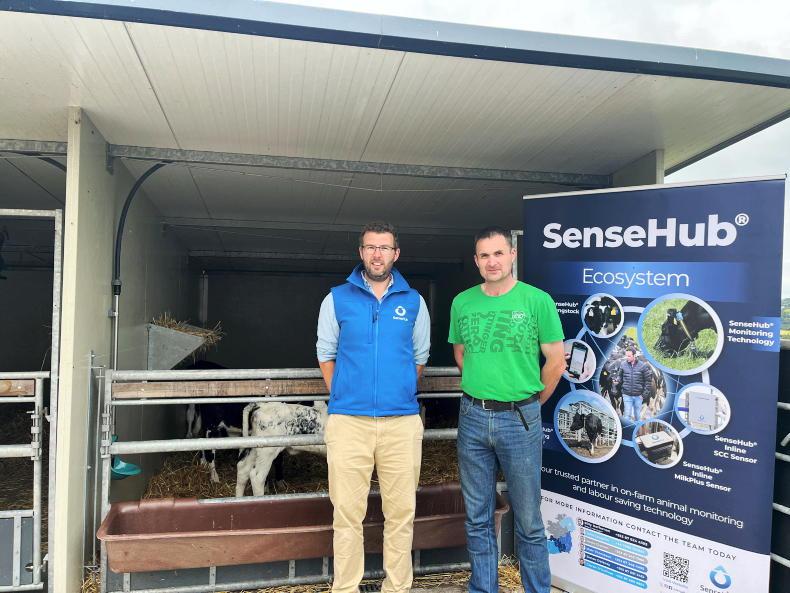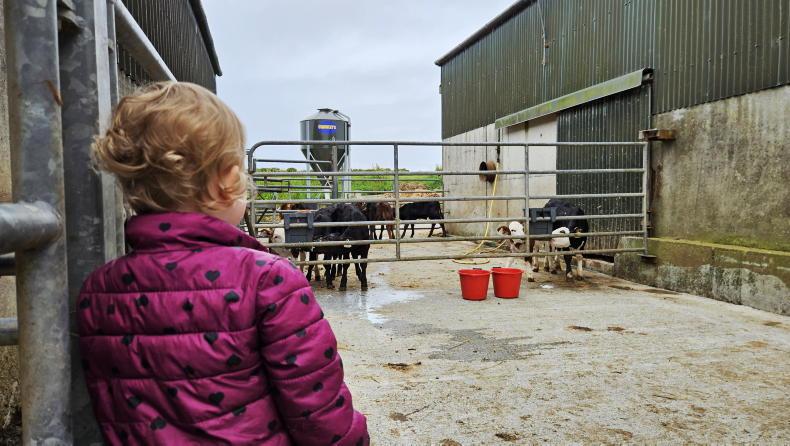The rearing phase of a dairy calf-to-beef system is by far the most labour-intensive for the farmer. It is natural, therefore, that by the time calves are weaned and turned out to grass, less attention can be paid to performance over the following few weeks.
However, this is often the period where daily liveweight gains plummet and calves stand still for a number of weeks, putting them behind target at an early stage in life.
A healthy calf is a must to have a thriving calf.
It is difficult to distinguish between calf health and nutrition as they are so intrinsically linked.
We must remember that at weaning, the rumen is still very much in the development stage. That is why any changes to diet should happen gradually over a period of time.
Even moving from the shed out to grass should ideally happen over the course of a few days where calves are out by day and in at night. This is because the microbes or bugs in the rumen that digest grass are different to the ones that will digest concentrate or even straw offered during the rearing phase. It will take the calf a number of days, or even weeks, to build up the population of grass-digesting microbes.
Potential health issues
At this stage, it is assumed that calves were vaccinated against pneumonia and have received two doses of a clostridial vaccination one month apart. These are essential tools in the toolkit of maintaining a healthy calf.
From now on, there are three main potential pitfalls over the first three months at grass – gut worms, lungworm or hoose and coccidiosis.
Due to more of their diet coming from grazed grass compared to suckler calves, dairy-beef calves are more susceptible to gut worms in the first season at pasture.
Symptoms: scouring calves and a rapid reduction in liveweight gain. Heavily infected calves will appear dull.Treatment: a number of faecal egg tests should be done throughout the first grazing season to identify when treatment is required. Cattle will develop immunity to gut worms after the first grazing season, but in order for this to happen they need to be exposed to the worms for a certain period.Talk to your vet about the best product to use, keeping in mind usage and effectiveness of products in the past.
It is a good idea to carry out another faecal egg test after treatment to see how effective the product was.
The type of dose that is used will alter the number of days post-treatment that the second, reduction test should be done, ie seven days after a yellow drench, 10 to 14 days after a white wormer and 14 to 16 days after a clear wormer.
Symptoms: lungworm or hoose is easily recognisable as a cough in grazing animals. In mildly infected animals, you will hear the odd cough as they graze or are at rest. The easiest time to identify lungworm is after moving cattle to a new paddock. If the cattle have run or exerted themselves in any way, there will be a lot of coughing where lungworm is present.Treatment: faecal egg tests can be used to determine lungworm. However, the disease is often caused by the larvae of the worm and therefore it is typically too late by the time the test can identify the problem. Cattle displaying the symptoms above should be treated. Most anthelmintics are effective against both the larvae and the adult lungworm, but, again, consult your vet in order to select the correct treatment. It may be combined with a treatment for gut worms, where necessary.Coccidiosis seems to be becoming more prevalent each year, with more and more farms reporting issues.
All calves will be exposed to cocci but that doesn’t mean they will get coccidiosis.
Coccidiosis usually occurs during a period of stress for the animal. This is typically around turnout when perhaps diets change too quickly or where the fibre source (straw or hay) from indoors is not available when calves move out to lush pasture. This can be enough to put a strain on the digestive system of the animal and result in an outbreak of coccidiosis.
Symptoms: typically seen in calves over a month old, usually after a stress period – mixing with new animals, turnout to grass, change in diet or even periods of poor weather. Calves will display a watery scour, often only passing a small amount of dung at a time as they are constantly straining and passing manure. Blood can be seen in the dung as the gut lining has been damaged. This results in a poor uptake of nutrients by the animal and can result in poor thrive and dehydration in many cases. Treatment: faecal sampling can determine coccidiosis in calves quite quickly. On farms with a history of the problem, treatment needs to occur prior to the stress period as a preventative measure. Minimise stress on the system and maintain fibre source to calves at pasture. Straw should be offered to calves for the first two months at grass.
The rearing phase of a dairy calf-to-beef system is by far the most labour-intensive for the farmer. It is natural, therefore, that by the time calves are weaned and turned out to grass, less attention can be paid to performance over the following few weeks.
However, this is often the period where daily liveweight gains plummet and calves stand still for a number of weeks, putting them behind target at an early stage in life.
A healthy calf is a must to have a thriving calf.
It is difficult to distinguish between calf health and nutrition as they are so intrinsically linked.
We must remember that at weaning, the rumen is still very much in the development stage. That is why any changes to diet should happen gradually over a period of time.
Even moving from the shed out to grass should ideally happen over the course of a few days where calves are out by day and in at night. This is because the microbes or bugs in the rumen that digest grass are different to the ones that will digest concentrate or even straw offered during the rearing phase. It will take the calf a number of days, or even weeks, to build up the population of grass-digesting microbes.
Potential health issues
At this stage, it is assumed that calves were vaccinated against pneumonia and have received two doses of a clostridial vaccination one month apart. These are essential tools in the toolkit of maintaining a healthy calf.
From now on, there are three main potential pitfalls over the first three months at grass – gut worms, lungworm or hoose and coccidiosis.
Due to more of their diet coming from grazed grass compared to suckler calves, dairy-beef calves are more susceptible to gut worms in the first season at pasture.
Symptoms: scouring calves and a rapid reduction in liveweight gain. Heavily infected calves will appear dull.Treatment: a number of faecal egg tests should be done throughout the first grazing season to identify when treatment is required. Cattle will develop immunity to gut worms after the first grazing season, but in order for this to happen they need to be exposed to the worms for a certain period.Talk to your vet about the best product to use, keeping in mind usage and effectiveness of products in the past.
It is a good idea to carry out another faecal egg test after treatment to see how effective the product was.
The type of dose that is used will alter the number of days post-treatment that the second, reduction test should be done, ie seven days after a yellow drench, 10 to 14 days after a white wormer and 14 to 16 days after a clear wormer.
Symptoms: lungworm or hoose is easily recognisable as a cough in grazing animals. In mildly infected animals, you will hear the odd cough as they graze or are at rest. The easiest time to identify lungworm is after moving cattle to a new paddock. If the cattle have run or exerted themselves in any way, there will be a lot of coughing where lungworm is present.Treatment: faecal egg tests can be used to determine lungworm. However, the disease is often caused by the larvae of the worm and therefore it is typically too late by the time the test can identify the problem. Cattle displaying the symptoms above should be treated. Most anthelmintics are effective against both the larvae and the adult lungworm, but, again, consult your vet in order to select the correct treatment. It may be combined with a treatment for gut worms, where necessary.Coccidiosis seems to be becoming more prevalent each year, with more and more farms reporting issues.
All calves will be exposed to cocci but that doesn’t mean they will get coccidiosis.
Coccidiosis usually occurs during a period of stress for the animal. This is typically around turnout when perhaps diets change too quickly or where the fibre source (straw or hay) from indoors is not available when calves move out to lush pasture. This can be enough to put a strain on the digestive system of the animal and result in an outbreak of coccidiosis.
Symptoms: typically seen in calves over a month old, usually after a stress period – mixing with new animals, turnout to grass, change in diet or even periods of poor weather. Calves will display a watery scour, often only passing a small amount of dung at a time as they are constantly straining and passing manure. Blood can be seen in the dung as the gut lining has been damaged. This results in a poor uptake of nutrients by the animal and can result in poor thrive and dehydration in many cases. Treatment: faecal sampling can determine coccidiosis in calves quite quickly. On farms with a history of the problem, treatment needs to occur prior to the stress period as a preventative measure. Minimise stress on the system and maintain fibre source to calves at pasture. Straw should be offered to calves for the first two months at grass. 









SHARING OPTIONS